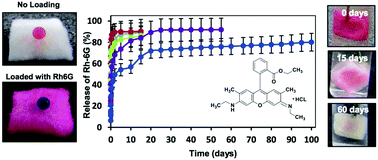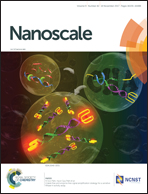‘Reactive’ nano-complex coated medical cotton: a facile avenue for tailored release of small molecules†‡
Abstract
Controlled and sustained release of drug-like small molecules in an aqueous medium still remains a challenging problem due to rapid infiltration of liquid water in most reported drug release systems. However, internal-superhydrophobicity with an antifouling property extending beyond the surface of a material recently has been recognized as a potential avenue for sustained and extended release of drug-like small molecules. Sluggish removal of metastable trapped air in a superhyrophobic material provides a basis to achieve extended release of encapsulated small molecules. In this article, naturally abundant medical-cotton—extensively used in wound management including control of bleeding, absorbance of secretions and protecting wounds from contamination—is strategically exploited in tailoring (from rapid to extended) the release of small molecules by appropriate modulation of liquid water wettability. Modulation included bio-mimicked adhesive and non-adhesive superhydrophobicity of the medical cotton without erosion of any polymeric material. In this process, amine ‘reactive’ nano-complexes (RNC) were prepared by just mixing branched poly(ethylenimine) (BPEI) with dipentaerythritol pentaacrylate (5Acl) in ethanol with appropriate compositions. Then they were covalently immobilized on fibrous medical-cotton through a facile and robust 1,4-conjugated addition reaction. Residual acrylate moieties in the immobilized RNC provide an opportunity to tailor water wettability through strategic and appropriate post-chemical modification of RNC-coated medical cotton with a primary amine containing various small molecules. This medical-cotton with tunable wettability was exploited further to control the release rate of small molecules from rapid (<24 h) to sustained (>100 days) times. A volatile solvent induced transient and reversible switching of anti-fouling properties which allowed further varying the amount of post-loading small molecules into the medical cotton up to 2.36 wt% without compromising the embedded anti-wetting property. Thus, our current approach has immense potential to develop appropriate materials for a sustained and controlled release of small molecules from a clinically relevant substrate (i.e., medical-cotton) and may be useful in various bio-medical applications including improving wound management, preventing bacterial infections, better pain management, etc.



 Please wait while we load your content...
Please wait while we load your content...